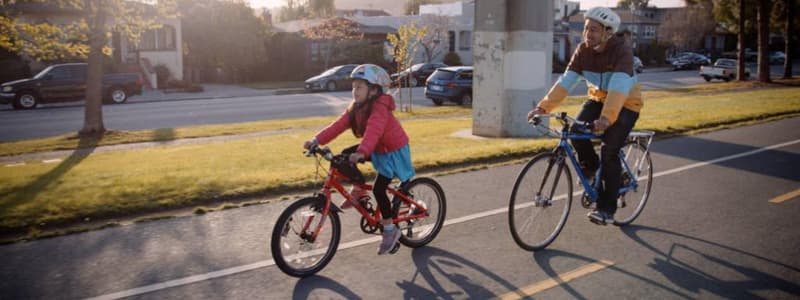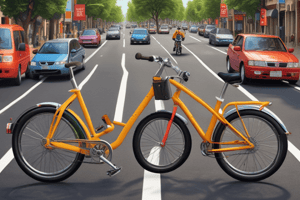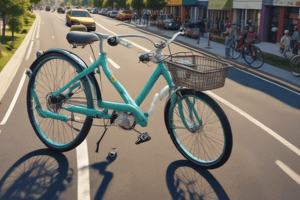Podcast
Questions and Answers
What should you remember to do when approaching or passing a bicyclist on a two-lane road?
What should you remember to do when approaching or passing a bicyclist on a two-lane road?
- Keep a safe distance between your vehicle and the bicyclist. (correct)
- Drive very close to the bicyclist to avoid hitting parked vehicles.
- Speed up to pass the bicyclist quickly.
- Honk your horn to alert the bicyclist of your presence.
When can you enter a bike lane before starting a turn?
When can you enter a bike lane before starting a turn?
- No more than 200 feet before starting the turn. (correct)
- After completing the turn.
- Directly at the intersection.
- As soon as you see the bike lane.
What should you do when merging behind a bicyclist to prepare for a turn?
What should you do when merging behind a bicyclist to prepare for a turn?
- Honk to signal your intention.
- Merge in front of the bicyclist abruptly.
- Pass closely to the bicyclist.
- Merge safely behind the bicyclist. (correct)
What should you be prepared to do when going through a work zone?
What should you be prepared to do when going through a work zone?
What are the consequences for assaulting a highway worker?
What are the consequences for assaulting a highway worker?
What should drivers do when merging near bicyclists?
What should drivers do when merging near bicyclists?
What is the best course of action when entering a bike lane for a turn?
What is the best course of action when entering a bike lane for a turn?
What should drivers do when instructed by road workers in construction zones?
What should drivers do when instructed by road workers in construction zones?
What should drivers do when faced with heavy traffic or bad weather conditions?
What should drivers do when faced with heavy traffic or bad weather conditions?
How should drivers behave when another vehicle is close behind them and wants to drive faster?
How should drivers behave when another vehicle is close behind them and wants to drive faster?
When should you give up your right-of-way according to the text?
When should you give up your right-of-way according to the text?
What does the blue and white sign at railroad crossings signify?
What does the blue and white sign at railroad crossings signify?
How should you behave when you are near a school according to the text?
How should you behave when you are near a school according to the text?
What should you do before entering an intersection?
What should you do before entering an intersection?
What is the significance of controlled intersections?
What is the significance of controlled intersections?
What should you do when a motorcyclist is trying to pass you?
What should you do when a motorcyclist is trying to pass you?
How should you react when you see an emergency vehicle with flashing lights and a siren?
How should you react when you see an emergency vehicle with flashing lights and a siren?
What should you do if you are in an intersection when you see an emergency vehicle?
What should you do if you are in an intersection when you see an emergency vehicle?
What should you do when entering a bike lane for a turn?
What should you do when entering a bike lane for a turn?
What should you do when obeying instructions from road workers?
What should you do when obeying instructions from road workers?
Flashcards are hidden until you start studying
Study Notes
Bicyclists on Two-Lane Roads
- Keep a safe distance and maintain speed when approaching or passing a bicyclist.
- Ensure to give adequate space, typically at least three feet, to avoid accidents.
Entering a Bike Lane
- Enter a bike lane before making a turn only when it is safe to do so, ensuring no bicyclists are present.
Merging Behind a Bicyclist
- Slow down and be prepared to yield if merging behind a bicyclist to safely execute a turn.
Work Zone Preparedness
- Remain vigilant and ready to adjust driving behavior; unexpected hazards may arise.
Assaulting Highway Workers
- Assaulting a highway worker can result in severe legal consequences, including fines and possible imprisonment.
Merging Near Bicyclists
- Always look out for nearby bicyclists and ensure a clear and safe merging process.
Entering a Bike Lane for a Turn
- Signal your intent early and check for bicyclists before entering a bike lane to execute a turn.
Following Road Workers’ Instructions
- Obey road workers' instructions promptly to guarantee safety for everyone in the construction zone.
Driving in Heavy Traffic or Bad Weather
- Exercise caution, increase following distance, and adjust speed appropriately to maintain safety.
Behavior When Followed Closely
- If a vehicle is closely following and wishes to go faster, consider safely changing lanes or allowing them to pass.
Right-of-Way Situations
- Yield right-of-way when necessary to avoid collisions and ensure safety, especially with pedestrians and emergency vehicles.
Railroad Crossing Significance
- A blue and white sign at railroad crossings indicates a potential hazard and alerts drivers to remain cautious.
School Area Protocol
- Drive carefully and be prepared to stop for children, as school zones require heightened awareness.
Intersection Precautions
- Before entering an intersection, assess potential risks and ensure that the path is clear of vehicles or pedestrians.
Controlled Intersections
- Controlled intersections utilize traffic signals or signs to manage the flow of vehicles, enhancing safety.
Passing Motorcyclists
- Exercise caution; maintain speed and do not change lanes abruptly when a motorcyclist attempts to pass.
Reacting to Emergency Vehicles
- Move over or stop when an emergency vehicle with flashing lights and siren approaches to allow for quick passage.
Actions in an Intersection with an Emergency Vehicle
- If caught in an intersection while an emergency vehicle approaches, remain in position and clear the way once safe.
General Bike Lane Entry
- Always check surroundings, signal, and enter a bike lane smoothly while ensuring it is safe to do so.
Road Workers' Directions
- Follow road workers' directions at all times to ensure safety in construction zones and compliance with regulations.
Studying That Suits You
Use AI to generate personalized quizzes and flashcards to suit your learning preferences.




